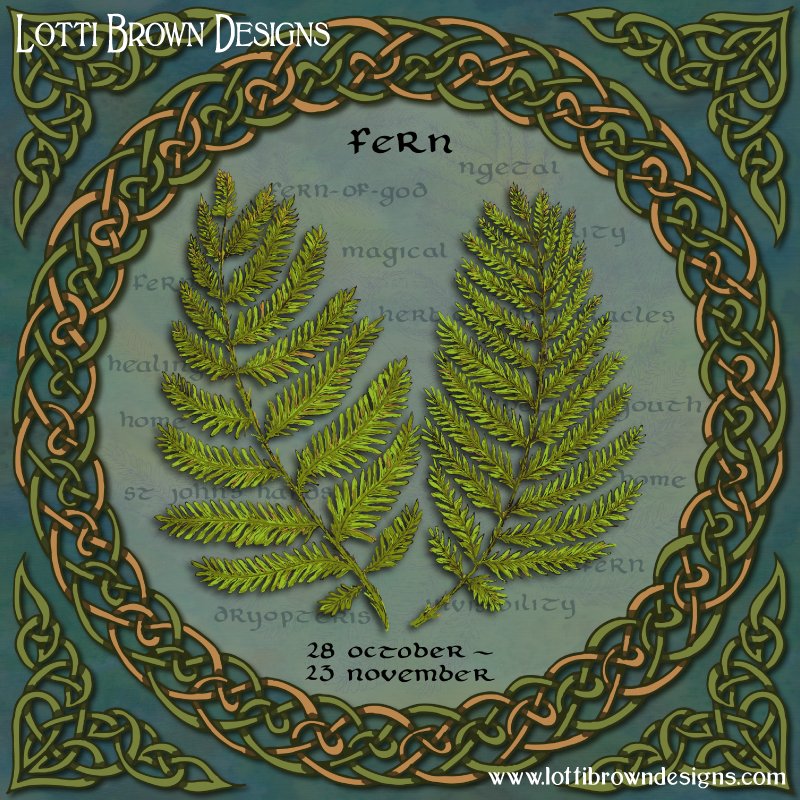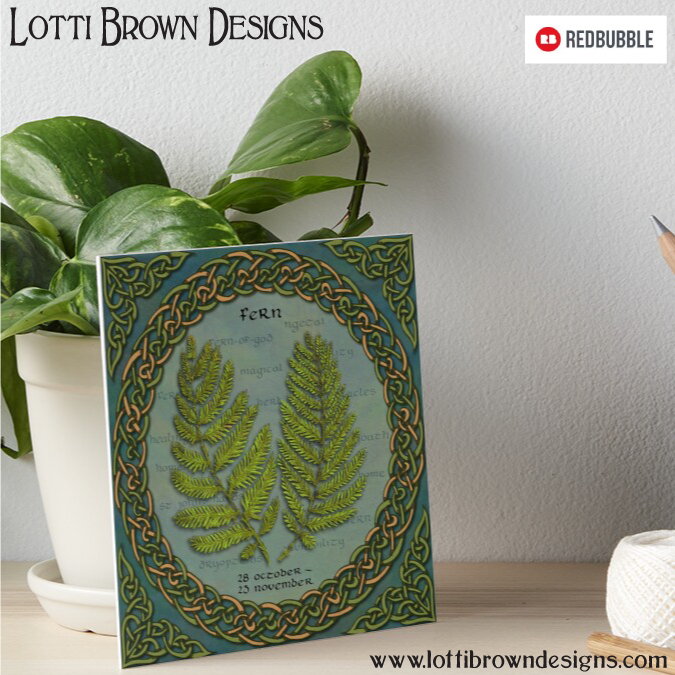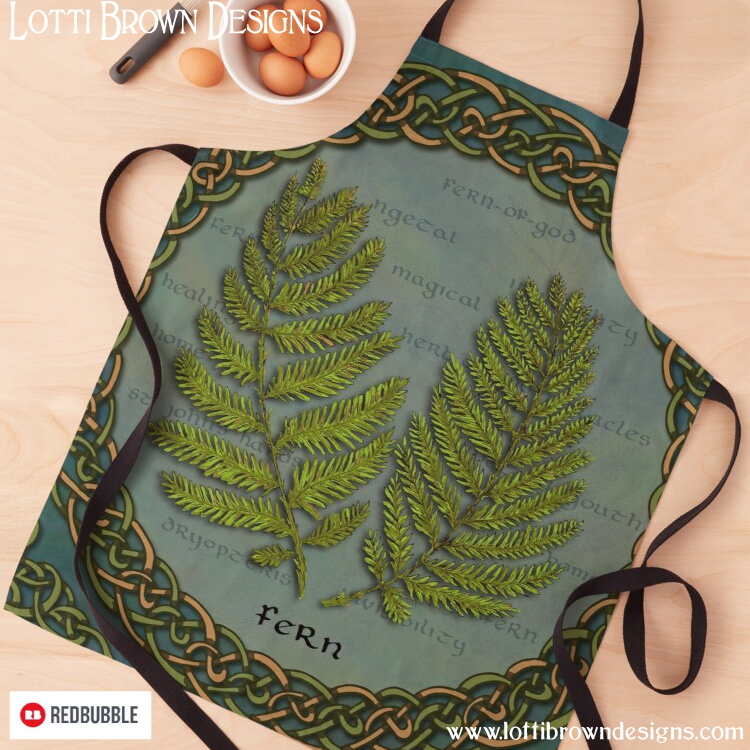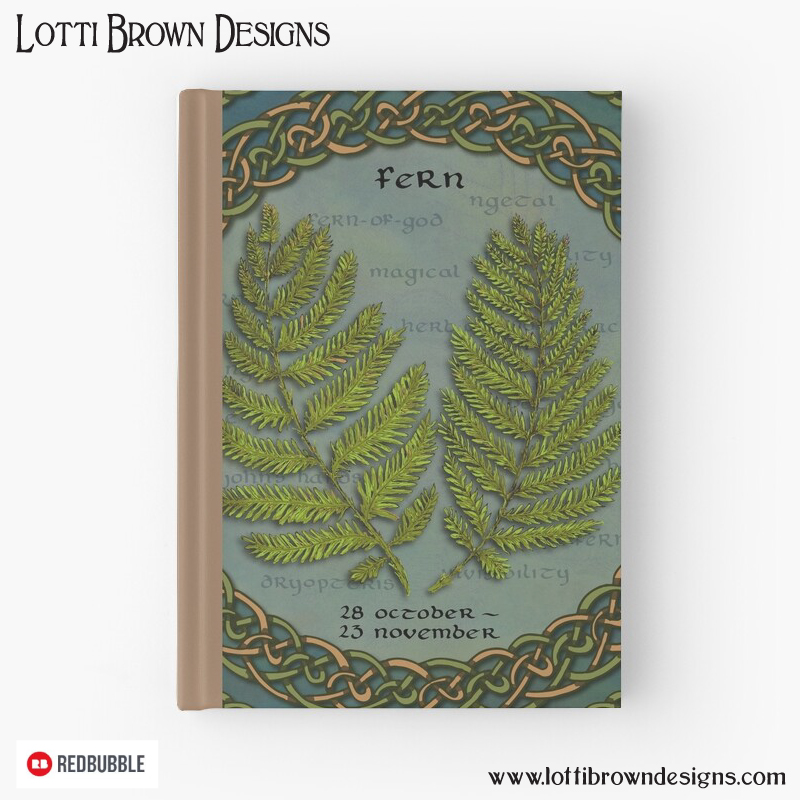*** IMPORTANT - I'm retiring my digital files - SVG/PNG/DXF/EPS - and printables from 31st December 2025 ***
*** Please ensure that you have everything you need - files and/or instructions printed off from the website (find them currently in the ARCHIVES section) - by 31st December 2025 as they will not be available after this date ***

Symbolism & Meaning of Fern
- Home
- Art - Living Archives
- Celtic Tree Art
- Fern/Reed
Explore the symbolism, myth and meaning of the fern (reed) as part of the Celtic Tree Calendar...
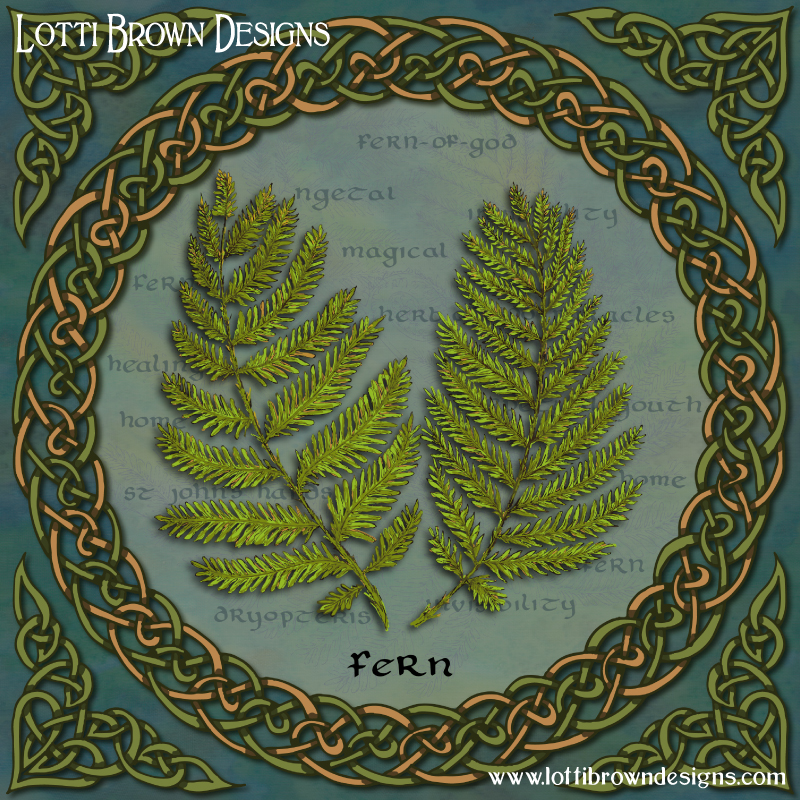 Celtic Ferns art by Lotti Brown
Celtic Ferns art by Lotti Brown(28th October to 23rd November)
This is part of my Celtic Tree Calendar art project which I did over 2020-2021 - you can find out about the Celtic Tree Calendar here and see my project here...
In Celtic times, the fern was associated with the ‘ngetal’ ogham - but there is actually some confusion over which plant or tree the ogham letter ‘ngetal’ actually refers to.
The Ogham Tract text, which dates from the 12th century, links fern to the ngetal ogham – but the earlier Scholars Primer links the ngetal ogham to broom.
Ngetal may also refer to reed, since the old Irish word for broom, ‘giolach’, also means reed. Occasionally it is thought to refer to dwarf elder.
It is likely that a specific plant was less important here than the use which the broom, reed, or fern could be put to, which uses were very similar, including thatching, fuel, bedding, compost or mulch.
I chose fern as it's a lovely plant to draw and a really interesting plant in terms of folklore, symbolism and meaning...
Symbolism and Meaning of the Fern
 Fern
FernThe fern is one of our oldest surviving plants – ferns were around even before the dinosaurs and date from the Mesozoic era (at least 66 million years ago).
The most common British wild ferns are:
- Male fern (Dryopteris filix-mas)
- Bracken (Pteridium aquilinum)
But there are over 40 wild fern species including the Maidenhair fern and the Moonwort fern.
Fern - 28th October to 23rd November
- Latin name: Dryopteris
- Irish/Gaelic name: Ngetal
- Common names: St John's Hands, Lucky Hands, Dead Man's Hands, Adder's Tongue Fern, Moonwort, Fern of God, Tentwort,
- Celtic tree calendar: 28th October to 23rd November
- Qualities: Magical, healing
- Associations: Invisibility, home, perpetual youth, adders, horseshoes,
The fern was a useful plant for our ancestors and we can get some clues as to how they used the fern through the common names used (sometimes still today) for the various fern species…
For example, the Adder’s Tongue Fern has leaves that look like a snake’s tongue – this was used as a remedy for snake bite, as well as various tongue conditions. But it’s wise to take care… as carrying this fern may well actually attract adders to you!
The Adder’s Tongue fern was also used to heal swellings as an eye lotion – it’s called the ‘herb of 100 miracles’ by the French.
The Male fern was sometimes called ‘St John’s Hands’, ‘Lucky Hands’, or ‘Dead-man’s Hands’ – the fern roots were collected on St John’s Eve (23rd June) and trimmed so that they looked like a hand, with fingers and thumb, and then baked in the oven. People would carry this ‘Hand of St John’ for protection at night.
The ‘Moonwort’ (Botrychium lunaria) was named for its half-moon shaped leaves – but it was also known as ‘Unshoo-the-horse’ due to its believed remarkable ability to work on metals. People thought that the moonwort fern could remove the nails from the horseshoes of any horses which stepped on it…
It is said that 30 of the Earl of Essex’s best horses all lost their horseshoes after stepping on moonwort while crossing White Down, Tiverton.
The moonwort’s abilities were so powerful that it was thought that moonwort gathered by moonlight could open locks, loosen hinges and turn quicksilver into pure silver – an impressive trick!
 Fern
FernThe Magical Fern
Ferns were believed to be highly magical. The fern’s most exciting magical property was the ability to make the wearer or carrier invisible!
The fern seeds were so tiny that people thought that the seeds were actually invisible – and so if you wore fern seed you would be able to become invisible too.
This was quite a commonly held belief – Shakespeare writes (in Henry VI) “We have the receipt of fern seed – we walk invisible.”
In the late 19th century, we also hear tell of a Scottish gentleman who recorded that his family were unable to see him after he’d crossed a ferny meadow!
People made quite some effort to gather fern seeds so that they could enjoy the undoubted benefits of invisibility. Those who would gather fern seed must do it on St John’s Eve (23rd June) at midnight. The fern seed (from bracken) must fall naturally from the plant without being shaken or touched…
A quantity of pewter plates was advised, too – 11 to be precise. It was said that the fern seed would slip through the first 10 plates but finally be caught by the 11th.
 Ferns
FernsIn Ireland, it’s said that one man was beaten all over by fairies as he attempted to gather fern seed in a box – all the while the fairies whispering their evils in his ears. By the time he’d reached home with his box of hard-won fern seeds, they’d all vanished!
Fern seed scattered amongst a store of money was said to ensure the wealth would never diminish.
The fern was believed to be a very powerful magical plant. In the 14th century Welsh legend of Taliesin ‘The Battle of the Trees’ (Cad Goddeu), fern is used to discover the god of the enemy, and thus their underlying power.
Fern has been known as the ‘death flower’ and ‘treasure fist’ because they were seen to grow on ancient burial mounds and there were guarded by the trolls within who kept the treasure there safe. The fern was said to signify the presence of such buried treasure.
The Male fern was considered as an aphrodisiac and the root was used in love potions – but it was also used as a steam inhalation to clear congestion in the head. It was also used to clear tapeworms – and even in World War Two, children were encouraged to gather the fern roots for this medicinal quality as a useful home remedy.
 Ferns
FernsBracken was known as the ‘Fern-of-God’ in Ireland and it was believed that if you cut through the stem you could read the initials of Jesus Christ (J.C.) or if you cut the stem into three parts, you may see G.O.D.
Perhaps you might just be lucky enough to read the initials of your future spouse in the bracken stem or see the image of an oak tree – maybe even with King Charles hiding inside it!
Taking a bite of the first bracken fern of Spring was believed to help you avoid toothache all year!
Or it’s just possible that fern could confer perpetual youth on you!
And fern tied to a horse’s ears could keep the devil away and confound witches so they couldn’t harm the horse.
But do take care if you’re considering uprooting a fern – pulling up a fern could cause a storm or may affect you to lose your wits!
Burning bracken could also affect the weather and was thought to bring rain! It was widely believed that, “the burning of ferne doth draw down rain.”
 Ferns
FernsBut if you burned fern leaves on 30th July, the feast day of St Abdon, the patron saint of cleanliness, and then scattered the remnants around the house, it could keep away insects – and any other unwanted guests!
It was said that you would lose your way and be followed by snakes if you wore fern…
But if you were a woman and were able to slip a fern into your beloved’s shoe, you would know he was yours forever (at least until he became lost to the wandering snakes!)
It was said that the Maidenhair fern (when mixed with bear grease, laudanum, lamp-black, and soot) would prevent baldness (so said Pliny).
And the small fern known as ‘wall rue’ (Asplenium ruta-muraria) was believed to keep witches away – but also was used as a remedy for rickets (‘the taint’) so giving it its other common name of ‘tentwort’.
The Healing Fern
Ferns have been used medicinally since ancient times. As well as the previously mentioned remedies –
- Maidenhair fern has been used for colds and as a cough syrup
- Dog fern could be used with shamrock and butter as an ointment to ease back ache
- Male fern was used as a cattle and sheep medicine for a condition called ‘fluke’ (in addition to being used for congestion and worms in humans)
- Ferns have a traditional use for constipation
Today, fern is considered toxic and should never be self-administered for any condition.
 Ferns
FernsSymbolism & Meaning of Fern
Fern was also a very practical plant and was used as fuel, for thatching, bedding (especially for animals), and as a compost or mulch. It was also gathered and burned to make potash which was used as an ingredient in glass and soap.
So ferns, while they may seem inconsequential plants today, were an important part of everyday lives in history - a useful plant for warmth and cleanliness in the home and stable and a vital nutrient in the garden.
It was common folk remedy that everyone had access to – and as such a special plant, seemed to have a particular power all of its own, for protection, treasure, power – and that ultimate, elusive, gift of invisibility!
Celtic Fern Art
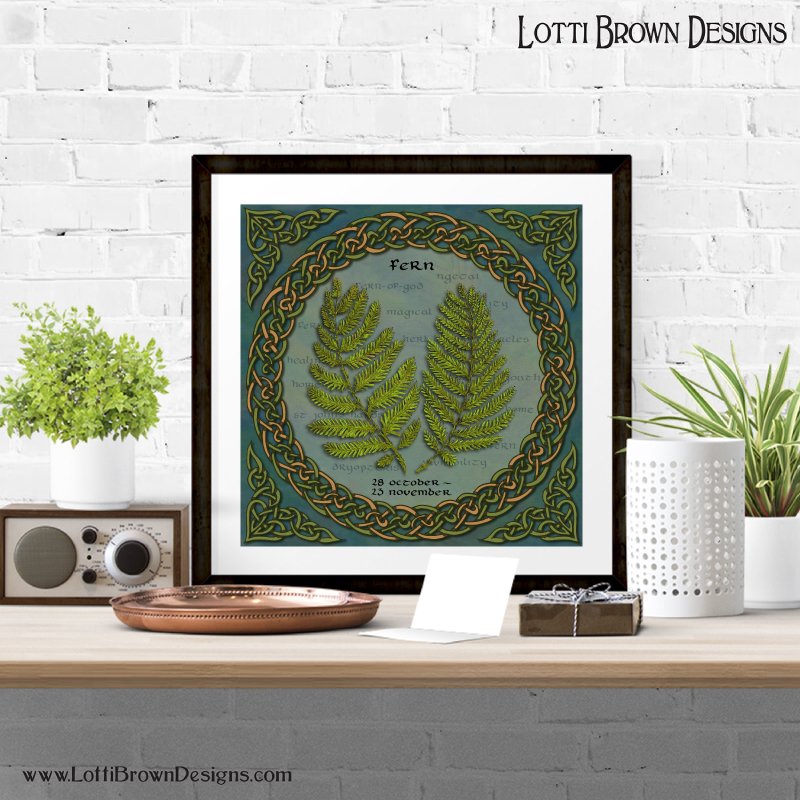 Celtic fern art 28th October to 23rd November
Celtic fern art 28th October to 23rd NovemberI created two versions of my Celtic Fern art - one with and one without the Celtic Tree Calendar dates for the fern (28th October to 23rd November):
- Undated version
- Dated version (28th October to 23rd November) - great for birthdays, anniversaries etc
Both the dated and undated versions are available from my Redbubble store as art prints (framed and unframed), notebooks and journals, mugs, throw pillows and blankets, silky scarves, phone cases, tech cases, T-shirts and sweatshirts and lots more...
Here's a little taster - you can click on each image below to be taken directly to the item, or browse everything available via the two links above (dated/undated), and also at the bottom of the page for your convenience...
Please be careful to select the correct version that you prefer - all items are available in both versions, so if in doubt, please select from one of the main dated/undated links and browse individual products from there!
How to Buy
Please remember there are two versions of my Celtic Ferns artwork - the standard version (no dates) and the Celtic Tree Calendar version with the dates for the Celtic Tree Calendar month of the Reed/Fern (28th October to 23rd November) - use the links here or just below to explore everything available in that version to find the print or product you want...
You might also like to explore the history of the Celtic Tree Calendar here...
Or take a look at some of the other months/trees here...
I also have more Celtic artwork here...
If you love nature, have you thought about starting nature journaling? Find out about nature journaling here...
Discover more British nature folklore in my Folklore Hub here...
Explore my current art collections here!
Further Reading
- Celtic Tree Magic – book by D. Forest
- Vickery’s Folk Flora – book by R. Vickery
- Discovering the Folklore of Plants – book by M. Baker
- Plant Lore and Legend – book by R. Binney
- The Illustrated Encyclopedia of Herbs – book by Chancellor Press
- The Druid Plant Oracle – book by P. & S. Carr-Gomm
- Grasses, Ferns, Mosses & Lichens of Great Britain and Ireland – book by R. Phillips
Please note that the information in this piece is for entertainment only and should not be used to diagnose or prescribe for health purposes.
Shall we stay in touch..?
Each month, I share stories from my own nature journal, new art from my studio, and simple seasonal inspiration to help you feel more connected with the turning year...
Recent Articles
-
British Nature Folklore Library: Stories, Seasons & Celtic Tree Wisdom
Dec 01, 25 05:09 AM
Explore British nature folklore, Celtic tree meanings, and seasonal wildlife stories. A growing library of myth, meaning, and hand-drawn inspiration. -
Beautiful Art Inspired by Nature
Dec 01, 25 05:04 AM
Beautiful folksy art inspired by nature from the fields and hedgerows of Yorkshire - colourful birds and wildlife with a nostalgic floral touch... -
Birds and Folklore in Britain: A November Nature Journal
Nov 26, 25 04:32 AM
November birds and berries - fieldfares, redwings, lapwings and snow geese with folklore, meaning and nature journal inspiration.
Follow me:
Share this page:

